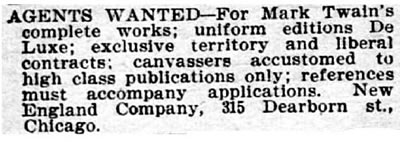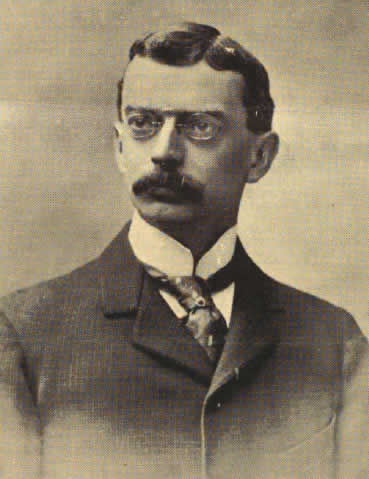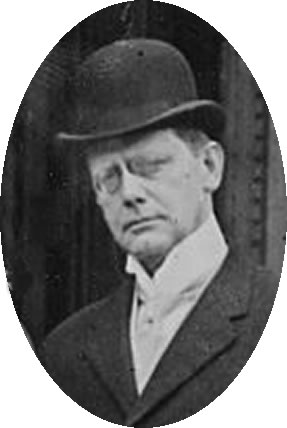
A History of and Guide to
UNIFORM EDITIONS OF MARK TWAIN'S WORKS
"Clemens had looked forward to the day when this should
be done, perhaps feeling that an assembling of his literary family in symmetrical
dress constituted a sort of official recognition of his authorship."
- Albert Bigelow Paine, Mark Twain: A Biography (1912)


St. Paul
[Minnesota] Globe, November 13, 1899 |

St. Paul
[Minnesota] Globe, February 11, 1900 |
_____
Chapter 4
1899 - 1901:
Eight American Publishing Company Editions and One New Harper Series
Reconstructing the Publishing Records
In April 1898 Frank Bliss anticipated producing three different
uniform editions of Mark Twain's works with prices ranging from expensive
$200 sets to more economical $50 sets. Bliss wrote to Henry Rogers that he
planned to call the sets: Author's Signed Edition, DeLuxe Edition, and Popular
Edition. Rogers, an enormously wealthy industrialist, continued to act as
Clemens's literary agent while Clemens lived abroad. Few American Publishing
Company records survive. The financial records of Henry Rogers are believed
to have been destroyed after his death. Mark Twain scholar Peter Messent writes
about Rogers, "His private and business papers appear to have been systematically
suppressed, destroyed, or kept in private hands" (Messent, p. 147). The
motive for such secrecy or destruction by Rogers's heirs remains open to speculation.
Some bookkeeping records of Harper and Brothers, the company that acquired
Mark Twain's copyrights from American Publishing Company in 1903, do survive
but many of Harper's records are vague and open to various interpretations.
Thus, the reasons behind the publishing decisions that surrounded the uniform
edition projects of both American Publishing Company and Harper and Brothers
must be partially reconstructed based on contemporary advertising and letters
that do survive.
American Publishing Company Editions
Advertising records indicate that hiring canvassers to sell
Mark Twain's sets in various parts of the country did not take place until
late in 1899. Printing and binding books before orders were placed for them
was not a practice Bliss and American Publishing Company followed because
it represented a gamble of whether or not the books would sell. American Publishing
Company issued eight different editions of 22 volumes in a three year time
span from 1899-1901. The first six uniform editions of Mark Twain's works
were:
These editions were printed from the same plates. All but the Popular Edition
were of limited numbers ranging between 512 and 1000 sets and each volume
in the set contained the specific number written by hand. The production of
these editions carried over into the year 1900. Volumes 1 through 21 of the
editions released in the United States were copyrighted in 1899. (Only the
first four volumes in the British edition issued by Chatto and Windus were
copyrighted in 1899.) On July 3, 1899 Clemens wrote William Dean Howells,
"I am ordering Bliss to send you my last book now and follow it with
the Uniform volumes as they appear. I think you will like the Uniform; it
promises to be a very handsome set of books. Bliss is taking great pains with
it" (Smith and Gibson, p. 704.) Volume 22 of the United States edition
was copyrighted in May 1900. American Publishing Company would later add a
Volume 23 in 1903. (In 1907, after the Harper and Brothers takeover of the
project, Volumes 24 and 25 were added.)
A letter written by George Gilman, representing American Publishing Company
to John Larkin, a Harper attorney, dated 13 October 1903 describes the production
numbers:
As to the uniform editions, the history of these is as follows: In 1899-1900
we printed and manufactured as follows: Autograph Edition, 512 sets; De
Luxe and Japan Editions combined, 1000 sets; a special De Luxe Edition sent
to England, 250 sets; Royal Edition, 1000 sets. These were all numbered
editions and were manufactured and some sold. What was left in our hands
of those numbered editions, were sold to Newbegin and Co., who afterwards
became known as the Anglo American Company, and for them we also published,
printed and manufactured the Underwood Edition of 2500 sets, the latter
portion of which edition was bound up different from the first portion,
and was labeled the Riverdale Edition (Gilman, 1903).
Gilman's letter indicates that production numbers were less than Frank Bliss
had projected in 1898. The numbers of some of the editions are far less than
previous bibliographers have realized. Limitation statements and numbers written
by hand inside the volumes are misleading because some of the sets were apparently
never produced to their maximum number.
American Publishing Company / R. G. Newbegin Editions
Larkin's letter indicates that Bliss had engaged with another company --
the R. G. Newbegin Company -- to sell the uniform editions. Historical records
indicate Robert Goodchild Newbegin was born in England in August 1854. He
immigrated to America in the early 1870s. His brother, John J. Newbegin, settled
in Montreal, Canada and later moved to San Francisco where he became a well-respected
book dealer. In April 1878, Robert Newbegin married Mary Van Dillen in St.
Louis, Missouri. In the 1880 census his occupation is listed as book agent.
Additional evidence indicates he worked as a representative for Gebbie Company
publishers. In the late 1880s Newbegin and his growing family relocated to
Erie, Pennsylvania where he worked as a manager for the mercantile agency
R. G. Dun Company. The Dun Company was the first commercial reporting agency
in America in the business of preparing credit reports on American businessmen
and companies. The company later became known as Dun and Bradstreet. In the
mid-1890s Newbegin and his family moved to New York where he was engaged in
the book publishing business.
In 1901 Bliss produced two editions of Mark Twain's works featuring the Newbegin
imprint:
According to George Gilman's letter, the total number of these sets issued
was 2500. The Riverdale Edition was a numbered set with a limitation number
of 625 with a handwritten number in red ink in each volume. The Underwood
Edition was unnumbered but probably totaled approximately 1875 sets.
Meanwhile ... Harper and Brothers Company Reorganizes
In 1899 Harper and Brothers publishers were experiencing their own financial
crisis and facing a possibility of collapse. Between November 1896 and August
1899 the company had borrowed approximately $850,000 from J. P. Morgan and
Company. The company had incurred additional unsecured loans amounting to
about $2,000,000. When Harper was unable to pay the interest on their loans,
an alliance with the S. S. McClure publishing company was attempted but fell
through. In November 1899 it was announced that the company had been reorganized
under the leadership and management of Colonel George Brinton McClellan Harvey.
J. P. Morgan gave his blessing to the arrangement.
| Beginning his newspaper career as a teenager,
by 1893 George Harvey had risen to the position of managing editor of
the New York World. His editorial support of Robert S. Green for
Governor of New Jersey helped Green get elected. Green appointed Harvey
to his military staff and awarded him the title of Colonel at age twenty-two.
Through his association with William C. Whitney, Harvey amassed wealth
in the business of developing electric trolley street railways. In 1899
Harvey purchased the North American Review magazine. Harvey was
thirty-five years old at the time he assumed leadership at Harper and
Brothers. His rise as a journalist and capitalist was described as "meteoric."
|
 George
B. M. Harvey (b. 1864 - d. 1928)
George
B. M. Harvey (b. 1864 - d. 1928) |

Frederick
A. Duneka (b. 1860 - d. 1919) |
By September 1900 Harper and Brothers had a new set of directors. Harvey
had undertaken to rebuild the business from the bottom up. As president
of the company, Harvey paid himself $25,000 a year -- less than ten
percent of what he had earned previously through his business association
with William C. Whitney.
Joining Harvey at the helm of Harper and Brothers was Frederick A.
Duneka, former city editor of the New York World. Duneka became
general manager and secretary of the Board of Directors.
|
Clemens was uneasy about his contract with Harper but by March 1900 he reported
to Henry Rogers, "The Harper statement payable May 1, for the last 6
months of '99 (as perhaps you already know) is $3,000, and double the previous
6 months. This is a handsome and business-like improvement, 8 old books (Leary,
p. 434). The "8 old books" would have been those issued by Harper
in the red cornstalk uniform bindings.
Colonel Harvey Adds Another Edition - 1901
Harper's Library Edition
According to Eugene Exman in House of Harper (1967), Clemens was one
of the first authors to whom George Harvey devoted his attention. Harvey visited
Clemens in London in the summer of 1900 obtaining a promise of exclusive rights
to future Mark Twain works. Harvey wrote Henry Rogers on October 17, 1900
proposing that Clemens autograph one hundred sheets that could be used in
the year 2000 in a special edition of Mark Twain's memoirs. Harvey suggested
a lavish luncheon announcing the scheme. In November 1900 Harvey signed a
contract with Clemens giving Harper rights to new articles that Clemens might
write paying him twenty cents a word for serial publications (Exman, p. 192).
The contract was in effect until January 1902 (Leary, p. 513.).
Harvey's "forte was publicity, and both his Harper success and his ultimate
downfall were largely due to his spending large sums of money on luncheons
and dinners and measuring his success in terms of the resulting lineage in
newspaper stories" (Exman, p. 200). Under the Harvey and Duneka leadership,
Harper and Brothers issued a new series of Mark Twain's works designated as
Harper's Library Edition
and an initial marketing strategy of selling them in sets of six designated
as "Mark Twain's Best Books." These six titles were works that Harper's
owned and had complete control over in 1901 even though they were also included
in American Publishing Company's uniform editions. Sales strategies for the
Harper's Library Edition
consisted of combining them with subscriptions to Harper's Weekly,
Harper's Monthly, or Harvey's own North American Review. Combining
Mark Twain's books in sets and marketing them as the "Best" had
the potential to create problems with the sales efforts of the American Publishing
Company. And it did.
References
Archives
of Harper and Brothers, 1817-1914 [58 microfilm reels]. (Cambridge,
England: Chadwyck-Healey; Teaneck, NJ: Somerset House, 1980).
Atherton,
Gertrude. My San Francisco: A Wayward Biography. (Bobbs-Merrill Company,
1946).
Blanck,
Jacob. Bibliography of American Literature, Vol. Two. (Yale University
Press, 1957).
"Col.
George Harvey Dies in Dublin, N.H.," The New York Times, 21 August
1928, p. 1.
Exman,
Eugene. The House of Harper. (Harper and Row, 1967).
Gilman,
George H. to John Larkin, 13 October 1903, reel #50 Archives of Harper
and Brothers, 1817 - 1914.
Harper,
J. Henry. The House of Harper: A Century of Publishing in Franklin Square.
(Harper and Brothers, 1912).
Johnson,
Merle. A Bibliography of the Works of Mark Twain. (Harper and Brothers,
1935).
Leary,
Lewis, ed. Mark Twain's Correspondence with Henry Huttleston Rogers 1893-1909.
(University of California Press, 1969).
Mark
Twain Project. Online database of letters and textual commentary at: http://www.marktwainproject.org
Messent,
Peter. The Short Works of Mark Twain: A Critical Study. (University
of Pennsylvania Press, 2001).
"New
Blood for Harper and Brothers," Newspaperdom, 23 November 1899,
p. 2.
"New
Harper and Brothers Company," New York Daily Tribune, 22 September
1900.
Paine,
Albert Bigelow. Mark Twain: A Biography [4 volumes]. (Harper and Brothers,
1912).
Rasmussen,
R. Kent. Critical
Companion to Mark Twain, Volumes I and II. (Facts on File, 2007).
"R.
G. Dun and Company." Online from Harvard University Library at http://oasis.lib.harvard.edu/oasis/deliver/~bak00110
Rodney,
Robert M. Mark Twain International. (Greenwood Press, 1982).
Smith,
Henry Nash and William M. Gibson, eds. Mark Twain - Howells Letters.
(Harvard University Press, 1960).







